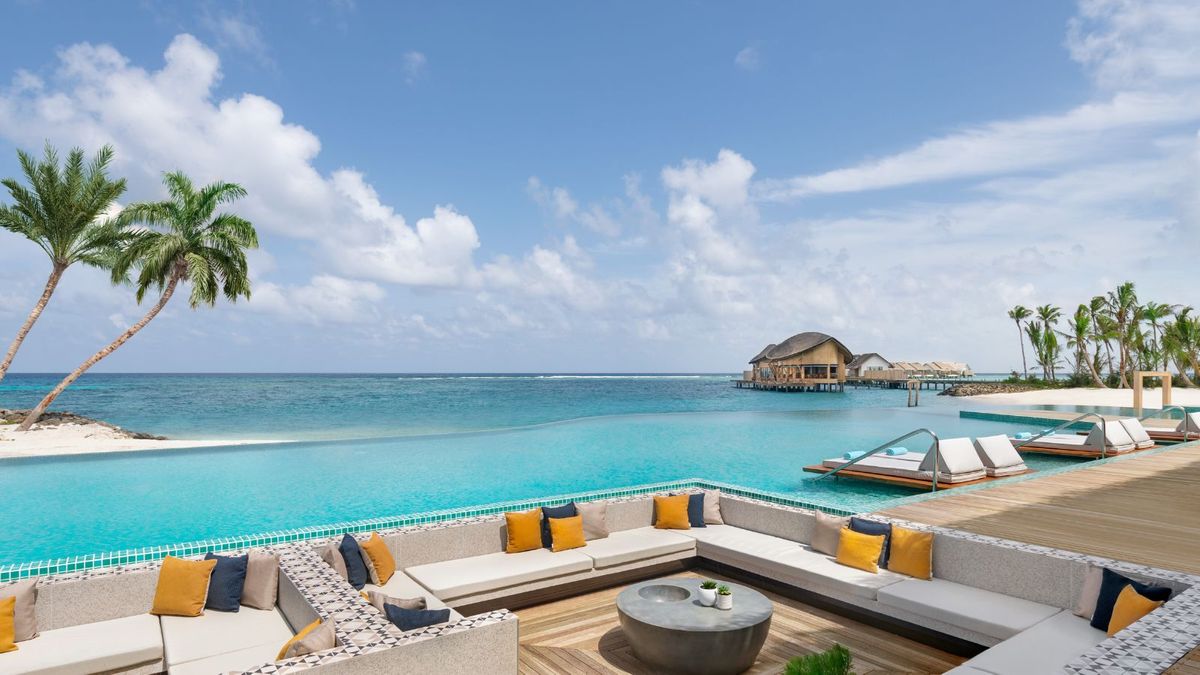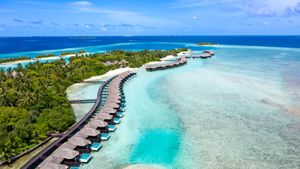In all my years as a travel writer, I have never been made to feel more aware of my ‘single traveller’ status than in the Maldives. Surrounded by a phalanx of couples (of all shapes, sizes, ages and orientations!)clearly here to celebrate and dressed to the nines, I feel like a stowaway on some sort of luxurious Noah’s Ark. And rightly so!

I am in the middle of the Indian Ocean. On a much-needed, solo trip to a tiny island that is part of the North Malé Atoll in The Maldives, to be more specific. It is here that the spanking new Hilton Maldives Amingiri Resort and Spa opened in early July this year, and finds itself languorously sprawled out amidst fragrant frangipani trees and swaying coconut palms called kurumba in the local Dhivehi language.
Solitary confinement

But my libation for the evening is a lot more potent than coconut water. Sipping my Aperol Spritz—a cocktail in a shade that’s a perfect match for the orangy-red sunset unfolding in front of me—at the resort’s Eden Champagne & Gin Bar, I’m in solitary heaven. Just as I wanted it to be; sans anybody else who would dilute this need of mine to be left alone in paradise.
It is where my personal guest experience manager and local Maldivian, Shaufa had made pre-dinner drink reservations for me earlier that day as I checked in. Always a phone call away (using the complimentary mobile phone provided by the resort), she’s been making sure all my creature comforts are being taken care of. From confirming Balinese massage reservations at the resort’s in-house Amingiri Spa to ensuring my overwater villa—that’s one of 109 all-pool beach and overwater villas—is well stocked with drinks and snacks for those in between mealtimes, it’s always Shaufa to the rescue.
Speaking of food, a multi-course ‘lobster tale’ themed dinner is what awaits me, I’m told. This is to be had at the Origin fine dining restaurant adjacent to Eden. Both of which sit atop the waters of the shallow lagoon on a wooden pier jutting out from the Amingiri’s white sanded beach. If I crane my neck in the right direction, I’m told that I can even see the twinkling lights of Malé, the capital island of The Maldives a bit farther.
And this is precisely why I’ve chosen to stay at this super-conveniently located resort. Not only does it give one the illusion of being confined to a remote island, but it is also just a short 20-minute complimentary boat ride away from Malé. A place that has always fascinated me for a variety of reasons. Some of which I soon discover the next day.
Malé bonding
Up early the next morning, I take the 8.15 AM speedboat to Malé where Shaufa has organised a guided, three-hour walking tour (USD 40) of the compact but densely populated city. I meet with Bond, which is what is Ibrahim’s ‘work name’. That’s trivia number one about Malé. Everybody has a separate work name and a home name. Just like they have in Thailand.
Malé can be explored on foot in less than an hour, North to South, East to West or circling it via the outer ring road called Marine Drive. A new satellite city called Hulhumalé that’s a reclaimed piece of land next to the Velana Airport is where most new offices and government buildings are located, given the sheer density of Malé. Hulhumalé even has an impressive range of budget accommodation options apt for those resort-shunning backpackers and solo travellers. Perfect for my next solo trip.

Back to the main Malé island, one of our first stops is the very unique Kalhu Vakaru Miskiiy or Travelling Mosque. Currently located next to the freshly refurbished Sultan Park in the very heart of Malé, this mosque is one that keeps changing its location every few decades. Made from both hirigaa (coral stone) and kalhu vakaru (lumber from the ebony tree) it can be fully dismantled very easily and set up just about anywhere. Ibrahim tells me that it has so far been located at the National Stadium and even on an island where a resort owner had purchased it after winning it in an auction and set it up there.

We also stop by the oldest structure in The Maldives which is the old Friday mosque called the Hukuru Miskiiy. A unique piece of architecture is the mosque's rather stout minaret that’s modelled on a lighthouse. Just opposite the mosque is the very modest, but the beautiful house of the President of The Maldives, Ibrahim Mohamed Solih. The bungalow—designed by a Sri Lankan architect in the colonial days—is also the best place to not only see, but also seek out the president for a selfie that he often obliges tourists with. I’m not so lucky, today!
As one of the city’s newest attractions that’s not even opened to the public, the new Friday Mosque overlooking the airport island stands out with its cobalt blue dome. Sponsored by Saudi Arabia, this one’s said to be a modern interpretation of Istanbul's Hagia Sofia.
Sea’s bounty

A short walk from the new mosque and still along Marine Drive, I find myself at the sparklingly clean fish market. It’s here that I see tuna of all shapes and sizes being sold by the kilo. Once purchased from the mongers, the fish is gutted and cleaned by a set of uniformed and gloved experts whose services can be purchased via a token bought at a separate counter.

It’s no big surprise that fish and mainly tuna is the number one choice of protein, given that there are no poultry or dairy farms anywhere in the archipelago due to sheer lack of space. In fact, in Malé other fish like stingrays are not even considered food with stingrays only used for their skin that’s turned into wallets and handbags made for export. Mackerel on the other hand is fermented and made into an unctuous chutney-like seafood condiment called rihaakuru and rarely ever eaten whole.
Much to my surprise as a major dog lover, somehow along the tour, I also learn that the city is totally devoid of any canine life. Though cats are aplenty, with kindly residents leaving food and water bowls outside their homes' stoops.
Parting shots

Just before I head back to the airport to catch my flight back home to Mumbai, we make a stop at Malé’s equally clean fresh produce market. It is here that I pack up a range of local Maldivian sweets to take back home as edible souvenirs.
From the cigar-shaped huvadhoo bon’di young coconut and treacle candies wrapped in dried banana leaves that the sellers jokingly call ‘Maldivian Bounty bars’ and the moreish sea almond, butter and coconut milk kanamadhu to the local version of bread pudding with coconut molasses called paan boakibaa, I make a neat little purchase. All in US dollars, which is a freely tendered currency all over the country.

I also pay the USD 6 taxi fare back to the airport that we reach by taking the new Sinamalé Bridge that the Chinese helped build. Readied in 2018, this bridge connects Malé with both the airport island of Hulhulé and with the similar-sounding new Hulhumalé island.
It’s then that my chatty driver imparts the last little factoid about tiny Malé. For an island roughly the size of my home city’s Azad Maidan (and then a little more...), it has not one, not two, not three, but 15 fleet cab companies. Size, in the case of Malé, clearly doesn’t matter, it seems!




